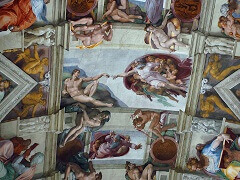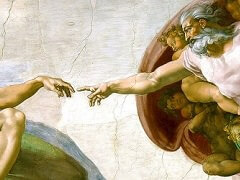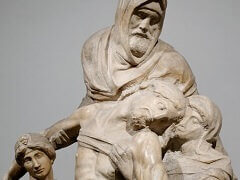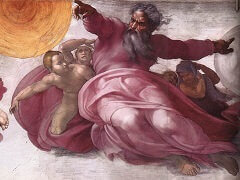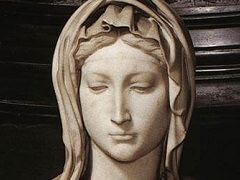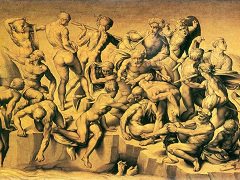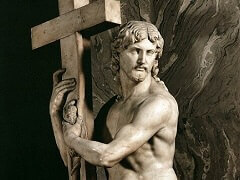The Deluge, by Michelangelo

The eighth scene in the chronological order of the narrative, Michelangelo's The Deluge painting on the Sistine Chapel ceiling, is depicted in the large field of the vault of the second bay,
between the triangular spandrels.
In the doctrine of the typological relationship between the Old and New Testaments, the Deluge was considered to prefigure baptism, while the Ark was the symbol for the Church itself. The
lustral water of the baptism removes the original sin, while that of the flood cleansed the world of sinners. Noah was saved from the water by the wood of the Ark, just as the wood of the Cross
offers salvation to those who are in the Church. Three different patterns of behaviour may be distinguished in human beings: while the righteous take refuge in the Ark (the Church) and find
salvation therein, the damned attempt to assail it, and others are lost due to their excessive attachment to worldly things, and seek safety carrying their possessions with them.
In fact, in the foreground of the fresco, the latter seek to flee from the threat of the rising waters by crowding onto the rocky islet on the right or by wearily climbing up to the high
ground on the left. In the distance, the wicked, having reached the platform surrounding the Ark, hurl themselves against the vessel from which they have been excluded. Lastly, those who have
reached a boat that is about to capsize, between the Ark and the hill in the foreground, are also engaged in a fierce struggle. The scenes of violence are countered by the behaviour of those
who do not seek their salvation at the expense of others, but display compassion and a profound sense of solidarity toward the weakest individuals who have been overwhelmed by the same calamity.
The large field, with the Deluge, is divided into several sections with some wonderful details, but these are not properly integrated. Their lack of coherence is partly justified in view of
the elemental catastrophe but it offends the aesthetic sense, not to mention the fact that this Deluge seems to be a dry affair. One has to compensate by looking at the groups of figures
reminiscent of antiquity yet full of new experiments and of movement; of naked human beings toiling, carrying or being borne away and resigned to their inevitable fates.
The destructive forces of nature and the elements are hardly indicated. This lack, noticeable in many of Michelangelo's drawings is a logical one. He sees all passion and torment, all toil
and victory in human terms; for him it is not the event itself which is decisive but its effect on those who experience it, expressed in movement and gestures. In their distress men may commit
wrongs near the capsizing boat and round the ark, but the scenes of mutual assistance and mercy preponderate, and it is precisely this which raises the perplexing question: why should all these
people perish? It is a great composition but one which still shows the influence of Signorelli and other painters; too involved, full of unsolved problems and over-crowded with detail. The
unifying synthesis is yet to come.


